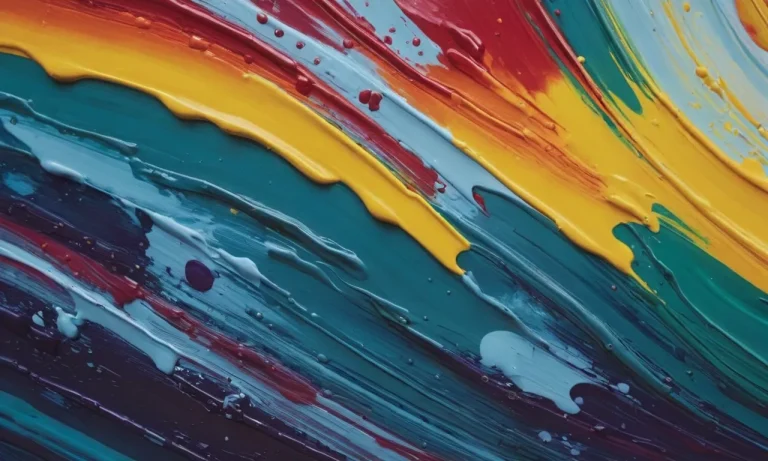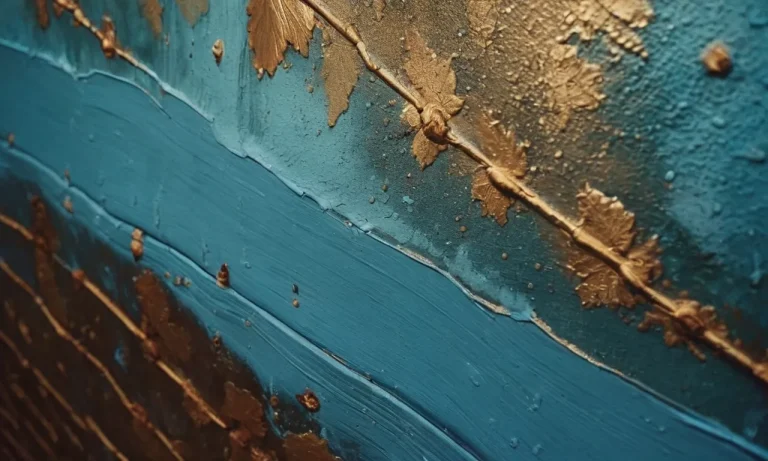Can You Paint Wet Wood? A Detailed Guide
Painting wood that is wet or damp is usually not recommended. The moisture prevents the paint from properly adhering and drying on the wood surface. However, if you’re in a pinch and need to get a coat of paint on wet wood, there are some tips and tricks you can try to help the paint cure correctly.
If you’re short on time, here’s a quick answer: You can paint wet wood if you use a water-resistant primer first and allow enough drying time between coats. The key is patience and multiple thin layers of paint.
Why Painting Wet Wood is Problematic
Painting wet wood can cause several problems that can affect the overall appearance and longevity of the paint job. It’s important to understand these issues before attempting to paint wet wood surfaces.
Moisture Causes Bubbling and Peeling
When paint is applied to wet wood, the trapped moisture beneath the paint film can lead to bubbling and peeling. As the moisture evaporates, it creates pressure that pushes against the paint, causing it to lift and separate from the wood surface. This can result in an uneven and unsightly paint job.
Additionally, the trapped moisture can create an ideal environment for mold and mildew growth, further compromising the integrity of the paint.
Prevents Proper Adhesion
Paint adheres best to dry surfaces. When applied to wet wood, the paint may not bond properly, leading to poor adhesion. Without a strong bond, the paint is more likely to chip, crack, or peel over time. This can result in a patchy and unprofessional-looking finish.
Proper adhesion is crucial for the paint to withstand wear and tear, weather conditions, and other external factors that can damage the wood surface.
Can Lead to Rot and Mold
Painting wet wood can trap moisture within the wood, creating a favorable environment for rot and mold to develop. Moisture seeping into the wood can cause it to become soft and weakened, making it more susceptible to rot.
Additionally, the trapped moisture can promote mold growth, which not only damages the wood but can also pose health risks to occupants of the space. It’s important to thoroughly dry the wood before painting to prevent these issues.
When Painting Wet Wood is Unavoidable
While it is generally recommended to paint wood surfaces when they are dry, there are certain situations where painting wet wood becomes unavoidable. Whether it’s due to unexpected rain, recently stained wood, or hard-to-dry surfaces, there are ways to work around these challenges and still achieve a successful paint job.
Outdoor Furniture That Gets Rained On
One common scenario where painting wet wood is unavoidable is with outdoor furniture that is exposed to frequent rain showers. Despite efforts to protect the furniture, it may still get wet and require painting.
In such cases, it’s important to wait until the wood is no longer actively wet to the touch. This can be determined by using a moisture meter or simply waiting for a few consecutive dry days. Once the wood is dry enough, it can be sanded, primed, and painted with appropriate outdoor paint to ensure long-lasting protection.
Wood That Was Stained Too Recently
Another situation where painting wet wood is unavoidable is when wood has been stained too recently. Stain needs time to properly dry and cure before applying paint on top of it. If you find yourself in this situation, it’s crucial to follow the stain manufacturer’s instructions for drying time.
Typically, it is recommended to wait at least 24-48 hours after staining before painting. This allows the stain to fully penetrate and dry, ensuring proper adhesion of the paint coat.
Surfaces That Are Hard to Fully Dry
There may be instances where certain wood surfaces are difficult to fully dry, making it necessary to paint them while they are still somewhat wet. This could be the case with wooden structures that are constantly exposed to moisture, such as docks or decks.
In situations like these, it is important to take extra precautions to ensure the best possible outcome. Using a moisture-resistant primer and paint specifically designed for wet environments can help provide added protection against moisture damage.
Regular maintenance and inspections should also be conducted to address any potential issues before they escalate.
It’s important to note that while painting wet wood may be unavoidable in certain circumstances, it is generally recommended to wait for the wood to dry completely before painting. This allows for better adhesion, durability, and overall quality of the paint job.
If you are unsure about whether it is safe to paint wet wood in a specific situation, it is always best to consult with a professional painter or a trusted source such as Bob Vila or This Old House for guidance.
Tips for Successfully Painting Wet Wood
When it comes to painting wet wood, there are certain techniques and precautions you need to take to ensure a successful outcome. Below are some tips to help you navigate the process:
Use an Oil-Based Primer
Using an oil-based primer is essential when painting wet wood. This type of primer is designed to bond well with damp surfaces and helps prevent moisture from seeping into the paint layers. Make sure to apply a generous coat of primer, allowing it to fully dry before moving on to the next step.
Allow Proper Dry Time Between Coats
Patience is key when painting wet wood. It’s crucial to allow each coat of paint to dry thoroughly before applying the next one. This not only helps the paint adhere properly, but it also prevents the formation of streaks or bubbles.
According to experts at Benjamin Moore, a leading paint manufacturer, allowing at least 24 hours of drying time between coats is recommended.
Apply Thin Layers of Paint
When painting wet wood, it’s best to apply multiple thin layers of paint rather than one thick coat. This helps the paint dry evenly and reduces the risk of peeling or cracking. Additionally, thin coats allow for better control and coverage, resulting in a more professional finish.
Use a Paint Sprayer for Exterior Surfaces
If you’re painting the exterior surfaces of wet wood, using a paint sprayer can be a game-changer. A paint sprayer provides a smooth and even application, ensuring that every nook and cranny is covered.
It also allows the paint to penetrate the wood fibers better, resulting in a longer-lasting finish.
Sand Between Coats
Sanding between coats is an important step when painting wet wood. Lightly sanding the surface helps remove any imperfections, such as brush strokes or drips, and provides a smoother surface for the next coat to adhere to.
Use a fine-grit sandpaper and wipe away any dust before applying the next layer of paint.
Pick the Right Weather Conditions
The weather conditions can significantly impact the success of painting wet wood. Ideally, choose a day when the humidity is low and the temperature is moderate. High humidity can prolong the drying time and affect the paint’s ability to adhere properly, while extreme temperatures can cause the paint to dry too quickly or not adhere well.
By following these tips, you can achieve a professional-looking paint job even on wet wood. Remember to take your time, use the right materials, and choose the optimal weather conditions for the best results.
How Long to Wait Before Painting Wet Wood
When it comes to painting wet wood, patience is key. It’s important to let the wood dry thoroughly before applying any paint or stain. This ensures that the paint adheres properly and that the finish is long-lasting. The amount of time you need to wait depends on the type of wood and its condition.
Here are some general guidelines:
At Least 24 Hours for Stained Wood
If you are planning to paint over stained wood, you should wait at least 24 hours before applying the paint. This allows the stain to fully dry and prevents any moisture from being trapped under the paint. Trapped moisture can lead to peeling and cracking of the paint.
It’s always best to follow the manufacturer’s instructions for the specific stain you are using, as some may require longer drying times.
1-2 Weeks for Fresh, Unprotected Wood
For fresh, unprotected wood that has not been stained or treated, it’s recommended to wait 1-2 weeks before painting. This allows the wood to dry naturally and reach a moisture content that is suitable for painting.
Painting too soon can result in a poor finish and may cause the paint to peel or blister. To determine if the wood is ready for painting, you can use a moisture meter to measure the moisture content. Ideally, the moisture content should be below 15%.
2-3 Days Minimum Between Paint Coats
If you are applying multiple coats of paint, it’s important to allow sufficient drying time between each coat. Generally, a minimum of 2-3 days is recommended between coats. This allows the previous coat to dry and cure properly before applying the next one.
Rushing this process can lead to a tacky surface and may affect the overall durability and appearance of the paint job.
It’s worth noting that these are general guidelines and the drying time may vary depending on factors such as temperature, humidity, and the type of paint or stain being used. Always refer to the manufacturer’s instructions for specific drying times and recommendations.
Signs the Wood is Too Wet to Paint
Wood Feels Cold to the Touch
One of the first signs that wood is too wet to paint is when it feels cold to the touch. When wood is damp, it retains moisture which can make it feel colder than dry wood. This is because moisture conducts heat away from the body faster than dry materials.
So, if you’re planning to paint, make sure the wood feels at room temperature before proceeding.
Surface is Visibly Damp
Another clear indication that the wood is too wet to paint is when the surface is visibly damp. If you notice water droplets or any visible moisture on the wood, it’s a sign that the wood hasn’t dried completely.
Painting on a damp surface can lead to poor adhesion and the paint may not adhere properly, resulting in a sloppy finish. It’s important to allow the wood to dry thoroughly before applying any paint.
Moisture Test Shows High Humidity
If you want to be absolutely certain whether the wood is too wet to paint, you can perform a moisture test. There are various moisture meters available in the market that can measure the moisture content of the wood. High humidity levels in the wood can indicate that it’s not ready to be painted.
It’s recommended to wait until the moisture levels are within the acceptable range before starting the painting process.
Wood is New or Has No Primer
Newly installed wood or wood that doesn’t have a primer coat can also be too wet to paint. When wood is freshly cut or installed, it often contains higher moisture content. Before painting, it’s advisable to let the wood acclimate to the environment and dry out naturally.
Additionally, applying a primer coat can help seal the wood and create a barrier between the moisture and the paint, ensuring better adhesion and longevity of the paint job.
Remember, painting wet wood can lead to a range of issues, including poor adhesion, paint peeling, and uneven finish. It’s always best to wait for the wood to dry thoroughly before applying any paint. If you’re unsure about the moisture content of the wood, consult a professional or use a moisture meter to ensure optimal painting conditions.
Conclusion
Painting wet or damp wood can lead to issues like bubbling, cracking, and poor adhesion. For best results, wood should be fully dry before painting. However, if timing demands that you must paint damp wood, be sure to start with a water-resistant primer and allow plenty of drying time between coats.
Apply multiple thin layers of paint rather than one thick coat for maximum durability. With proper preparation and patience during the application process, even wet wood can be painted successfully.







